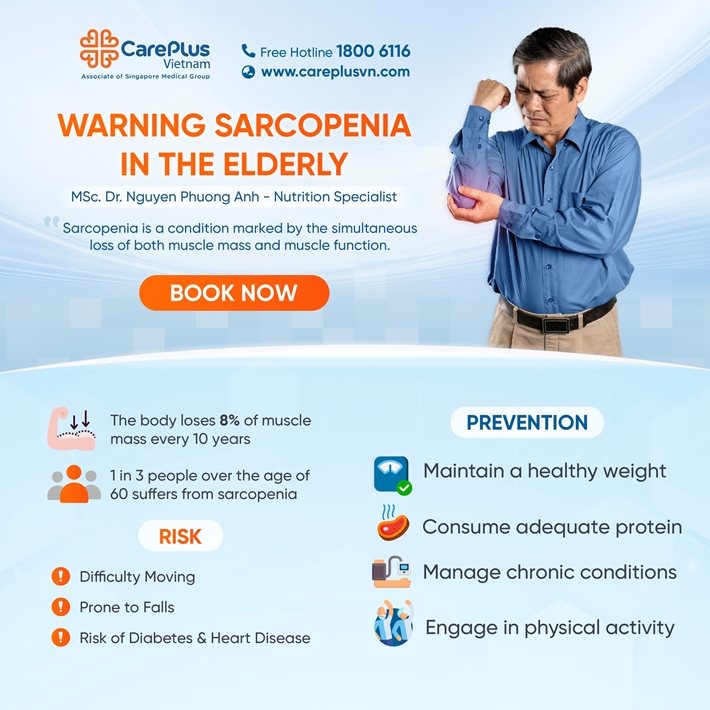SARCOPENIA IN THE ELDERLY - A SILENT CONDITION WITH SEVERE IMPACT
Sarcopenia (muscle wasting) in the elderly is a condition that progresses silently yet has severe impacts on daily health and functioning. Check out the CarePlus expert advice on nutrition and physical activity to help prevent muscle wasting.

12/2/2024 2:27:04 PM
⌛ Once they reach 60, the health of our elderly loved ones begins to degenerate, exposing them to various potential risks. Among these is sarcopenia, also known as muscle loss, a serious issue that can lead to significant challenges. Without timely detection and intervention, sarcopenia can hinder basic daily activities, such as getting up from a chair, walking, opening a jar, or carrying groceries, increase the risk of falls, and even cause loss of independence in daily life.
👉 So, what exactly is sarcopenia, and how can we prevent this condition in our loved ones? Let’s take a look at the advice from MSc. Dr. Nguyễn Phương Anh - Nutrition Specialist at the CarePlus International Clinics.
1/ How does sarcopenia affect the health of the elderly?
↘️ Sarcopenia is an age-related condition marked by the simultaneous loss of muscle mass and function. Research indicates that between the ages of 40 and 70, the body loses an average of 8% of muscle mass every 10 years, a rate that rises to 15% after age 70. A 2021 study conducted in Singapore found that 1 in 3 people over the age of 60 suffers from this condition.
⚡ As muscles weaken, elderly individuals become more prone to balance loss, falls, and injuries, which can reduce their ability to care for themselves, work, and engage in daily activities. Furthermore, sarcopenia can slow recovery after illness or surgery, increasing the risk of chronic diseases such as diabetes and heart disease. Preventing sarcopenia through a balanced diet and regular physical activity is thus essential to enhance the quality of life in older adults.
2/ Key principles of nutrition and exercise to prevent sarcopenia
✅ Maintain a healthy weight: Both undernutrition and obesity increase the risk of sarcopenia through different mechanisms. Nutrient deficiencies prompt the body to break down muscle for energy, while obesity leads to excess fat storage, adding strain during physical activity and releasing inflammatory substances that reduce the ability to maintain and restore muscle mass.
✅ Ensure sufficient protein intake in the daily diet, focusing especially on leucine (found in eggs, beef, chicken, sesame seeds, peanuts, etc.) or HMB.
✅ Manage chronic conditions such as diabetes, heart disease, and arthritis. These conditions are often associated with chronic inflammation, which accelerates muscle breakdown and reduces recovery potential.
✅ Engage in physical activity: Exercises that strengthen muscle mass, such as light weightlifting or resistance band training, help maintain muscle mass. However, for older adults, it’s important to select exercises that suit their age and health conditions.
↘️ Over time, muscle mass and strength diminish without clear signs, making it difficult for the elderly and their families to recognize until it has progressed into complex sarcopenia.
If you notice signs of muscle wasting in your elderly loved ones, don’t hesitate to contact CarePlus, where our experienced Nutritionists can provide accurate diagnosis and tailored advice on diet and exercise.
👉 To schedule an appointment, please call our free hotline at 1800 6116.
CAREPLUS INTERNATIONAL CLINICS
Associate of Singapore Medical Group
Hotline: 1800 6116
Email: info@careplusvn.com
Fanpage: CarePlus Clinic Vietnam